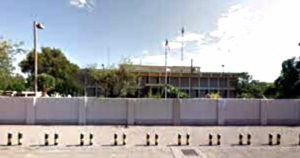
05 Jun Botswana — A Little Bit of America Overseas
I’d always imagined our embassies were stately affairs, welcoming, yet dignified. Tastefully appointed with paneled offices, carpeted floors and elegantly dressed diplomats discussing matters of state in precise, measured tones. Our best face forward. A little bit of America overseas. At least that’s what I imagined until Peggy and I arrived in Botswana and went to the embassy to be briefed by the Regional Security Officer.
There might have been some elegance lingering somewhere. The ambassador’s office, perhaps. A special place for important foreigners to see the way we’d like to show ourselves to the world, but I wouldn’t know. I didn’t work at the embassy. But, even if I had, I probably still wouldn’t know. They kept the ambassador tucked away in a place that was so secure that other people at the embassy weren’t even allowed on the floor without special badges.
The part Peg and I did get to see, there’s no other way to put this, really was a little bit of America overseas: desks littered with files, two people shoved into offices built for one, chipped linoleum, ugly paint, flickering fluorescent tubes, a cafeteria with clammy, plastic-wrapped sandwiches in gloomy refrigerator cabinets – just like the crappy Federal office buildings all across America. I’d have pictures but the marines made me leave my camera at the door. I think they were embarrassed.
The outdoor parts were more welcoming. A tidy, white building.

Sacred ibises wandering about.

Shady trees. An elegant, formal drive.
But to be welcomed, you had to get into the compound, which was easy enough if you were a sacred ibis. But not so much for everybody else. From the street the place was a forbidding wall

pierced with a sliding steel gate for cars and those knife things that come out of the pavement and rip your tires apart if you try to shoot across too soon.
The Residence is where the elegance was. The ambassador lived there and it flew a big American flag when she was in town. When she wasn’t, the flag was furled and the Deputy Chief of Mission ran things . . . at some embassies, for years, when the Senate couldn’t agree on a new ambassador.
The Residence was open and airy and set in a spacious compound with an enormous patio for entertaining. It was hung with art the ambassador personally chose from an art warehouse in DC. Also, there was a lot of porcelain and formal glassware.
Outside, was a garden with a swimming pool shining in the Kalahari sun. Privacy at the pool was insured by the high wall that separated the Residence from the place next door where the Russian ambassador lived. The pool was the fiefdom of the ambassador’s big, playful, goofy, decidedly undiplomatic dog. No human had swum there since the reception at the South Korean embassy when the Russian ambassador, perhaps into the vodka, perhaps not, had mentioned how charmed he was by the dog he wasn’t supposed to be able to see through the wall.
Not only was our ambassador responsible for advancing American interests overseas, she was responsible for the crockery. If something broke, she was required to sweep the pieces into the diplomatic pouch and send them to DC where they’d be reassembled by experts in dinnerware forensics to make sure they added up to the number claimed and she wasn’t trying to loot her own home.
It turns out there really are such things as diplomatic pouches. I’d always figured pouches were something they had back when Jefferson was in Paris representing the Washington administration, but that they’d gone out of fashion along with ruffled shirts for men and three-masted ships for trans-Atlantic communication. Nowadays, I’d assumed, they were just a section in the cargo hold of an airplane marked DIPLOMATIC MAIL.
I’d assumed wrong.
You can recognize a pouch at a distance if you’re the kind of person who can recognize one at all. I never saw one but I imagine they’re large, reinforced-canvas mailbags with complicated locks and the Great Seal of the United States emblazoned on the side. And that they are very carefully guarded.
It’s okay to send pretty much anything you want through the pouch, including Christmas trees, so long as it won’t catch fire or blow up or give somebody anthrax. They have a rule about tires, though. You’re not allowed to order a set of tires through the pouch. So people do the obvious thing, they buy tires one at a time. Nobody seems to mind if tires come through the pouch one at a time, even if all four come one at a time at the same time.
Lithium batteries are another story. You absolutely cannot send a lithium battery through the diplomatic pouch. Lithium batteries catch fire and can cause an entire airplane to crash, which occurred a few years ago to a cargo plane flying over the Arabian Desert. When that happened, lithium batteries got banned so quickly nobody even knew about it until the cameras they’d ordered for Christmas presents didn’t show up along with the trees. Later on, when it turned out that what really happened was the Ink-Cartridge Bomber had slipped an ink cartridge onto the plane, the rule about lithium batteries stayed on the books. You can never be too careful.
Even when they don’t have dangerous exploding camera batteries inside, diplomatic pouches don’t seem to have much priority. Back when she was still an ordinary diplomat, the ambassador was at the Miami airport looking at the plane she was about to take to Jamaica, when the pouch was wheeled out and hoisted into the cargo hold. A few minutes later another baggage truck came up, this one loaded with sacks of flour for the street vendors in Kingston. The street vendors must have seen a busy week coming because there wasn’t enough room on the plane for all that flour. So, the people in charge hoisted the diplomatic pouch down, loaded on the flour, then drove the pouch back to the terminal.
Not that putting Priority Mail stickers on the pouch would have speeded things up much. Diplomatic pouches are subject to all the same slow-motion processes that everything the Feds get their hands on is subject to. If you send a letter to Botswana through the Diplomatic Post Office, it goes to Dulles, Virginia, where it’s x-rayed for exploding batteries, sniffed by bomb-sniffing dogs, ultraviolated to kill the anthrax, sorted, bundled, put in the pouch and sent to the airport where, bags of flour permitting, it’s loaded on a plane to Frankfurt.
At Frankfurt it’s unloaded, hauled into a sorting room, unbundled, re-x-rayed, re-sniffed, re-ultraviolated, re-sorted, rebundled, re-pouched and, space permitting, put on a flight to Pretoria. Where it goes through the same processes all over again before flying Air Botswana to Gaborone, being trucked to the embassy, unpouched, unbundled, and meted out the next time you drop by the window to pick up your mail. The whole thing is so slow that nobody notices when a pouch doesn’t arrive at all.
One September, Peggy mailed our son a World-Cup T-shirt. Come March, she noticed he hadn’t mentioned anything about getting a World Cup T-shirt, which was so unlike him it didn’t even occur to her to question him about it. Instead, at a formal meeting with the ambassador and the heads of other US agencies, she asked about the pouch.
Now that she’d brought it up, that did kind of ring a bell. Several people had sent letters they hadn’t gotten answers to, an investigation was launched, and the United States Diplomatic Pouch was found leaning against a wall in O R Tambo Airport in Johannesburg where it had been leaning for six months. And Johannesburg, not to put too fine a point on it, is not noted for its lack of crime.
Later, the security people contacted the embassy again. Another pouch had turned up. This one, on the shores of the Indian Ocean. They’d been able to identify most of the things still inside, “But, can anybody please tell us who owns the one green shoe?”


No Comments